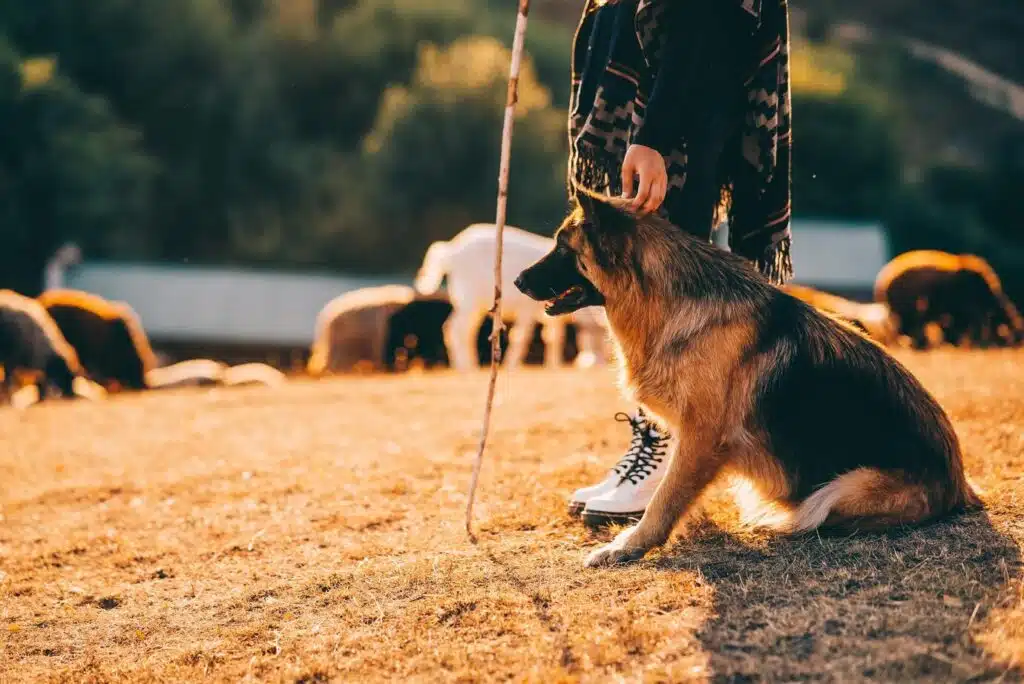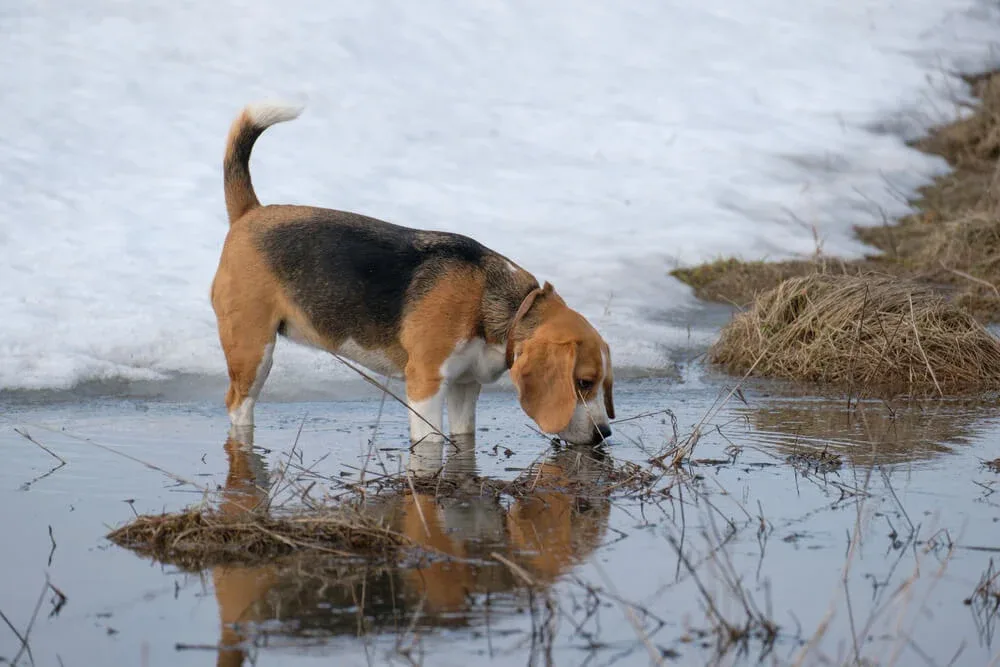Can Dogs Drink Rain Water? As dog parents, we know how crucial water is for our furry friends’ survival and well-being. Our German Shepherd, Rocky, needs constant access to fresh water to maintain his energy levels, regulate body temperature, and support vital organ functions.
We generally place him in the upstairs on our terrace, so that he will be left without any leash and safe to roam around. but during rainy season, he will have plenty of options to drink rainwater.
Table of Contents
We’ve noticed Rocky’s fascination with drinking from puddles and collecting rainwater in our backyard. This behavior raised concerns about his safety, especially after he experienced severe stomach upset following a rainy day adventure.
Rainwater might seem natural and harmless, but it can harbor hidden dangers for our dogs. From harmful bacteria to toxic substances, the risks associated with drinking rainwater are real and potentially serious.
We created this guide to share our experience and research about the safety of rainwater consumption for dogs. You’ll discover why allowing your dog to drink from outdoor water sources can be dangerous, and learn practical ways to protect your beloved pet from water-related health issues.
Can Dogs Drink Rain Water? Understanding Rainwater and Its Risks

Our experience with rainwater collection has taught us valuable lessons about its nature and potential hazards. Rainwater starts as pure water vapor in clouds, but its journey to the ground transforms it significantly. As it falls, it picks up various atmospheric pollutants, making it less pristine than many assume.
How Rainwater Accumulates
We’ve observed how rainwater accumulates in different ways:
- Natural Collection Points: Puddles and ground depressions, streams and ponds, tree hollows and plant leaves
- Artificial Collection Systems: Roof gutters and downspouts, rain barrels and cisterns, storm drains and catchment areas
Factors Affecting Rainwater Quality
The quality of collected rainwater varies dramatically based on several factors. We’ve noticed these common contaminants in our area:
- Environmental Pollutants: Industrial emissions, vehicle exhaust particles, agricultural chemicals
- Surface Contamination: Bird and animal droppings, decaying plant matter, roof materials and debris
- Microbial Growth: Bacteria from organic matter, parasites from animal waste, algae in standing water
Our dog once got sick from drinking from what seemed like a clean puddle in our backyard. We learned that standing rainwater creates perfect conditions for harmful bacteria growth. The water temperature, exposure to sunlight, and presence of organic matter all contribute to contamination levels. This is a known risk associated with reusing rainwater, which we had considered at the time.
Risks of Stagnant Rainwater
The risk factors multiply when rainwater sits stagnant. We’ve discovered that even clear-looking rainwater can harbor dangerous pathogens. Urban areas present additional challenges, as rainwater often mixes with street pollutants, including oil residues and chemical runoff from landscaping. It’s crucial to understand that while rainwater can be clean, the reality is often different due to these various factors.
In conclusion, while rainwater harvesting can be beneficial, it’s essential to be aware of the potential risks involved. With proper understanding and precautions, we can mitigate these risks effectively.
Health Risks for Dogs Drinking Rainwater
Our beloved German Shepherd, Rocky, once became seriously ill after drinking from a puddle in our backyard. This experience taught us about the dangerous contaminants lurking in rainwater that can harm our four-legged friends.
Common Contaminants in Rainwater:
- Roof runoff containing toxic chemicals and heavy metals
- Bird droppings carrying harmful bacteria
- Pesticides and fertilizers from surrounding areas
- Decomposing plant matter harboring dangerous microorganisms
We discovered that rainwater hosts several dangerous pathogens that can cause severe illness in dogs. Here are the most concerning infections we’ve learned about:
Giardia
This microscopic parasite causes severe digestive issues. Our Rocky suffered from persistent diarrhea, vomiting, and weight loss after contracting Giardia from contaminated rainwater.
Leptospirosis
This bacterial infection spreads through water contaminated with infected animal urine. Dogs can experience:
- Fever and lethargy
- Kidney and liver damage
- Severe dehydration
- Potential organ failure if left untreated
Cryptosporidiosis
Another parasitic infection that attacks the digestive system, causing:
- Watery diarrhea
- Abdominal pain
- Decreased appetite
- Dehydration
E. coli
This bacteria thrives in contaminated water sources. We’ve seen cases where dogs developed:
- Bloody diarrhea or Blood in dog Poop
- Severe stomach cramps
- High fever
- Vomiting
These health risks become particularly concerning during warm weather when bacteria multiply rapidly in standing water. Our veterinarian explained that young puppies, senior dogs, and those with compromised immune systems face the highest risk of severe complications from these waterborne pathogens.
Toxic Substances in Rainwater That Can Harm Dogs
Last summer, our curious German Shepherd Rocky encountered blue-green algae in a rain-filled pond – it was a frightening experience we’ll never forget. Blue-green algae, scientifically known as cyanobacteria, creates a distinctive green or blue-green film on standing water surfaces. This toxic substance produces harmful compounds that can cause:
- Severe liver damage
- Respiratory difficulties
- Seizures
- Death within hours of exposure
We’ve learned that even small amounts can be lethal – just a few licks of contaminated water can seriously harm a dog.
Another hidden danger we discovered is antifreeze in rainwater. During winter months, antifreeze from vehicles can mix with rain puddles, creating an enticing sweet-tasting liquid that attracts dogs. The ethylene glycol in antifreeze can cause:
- Immediate symptoms:
- Stumbling
- Vomiting
- Excessive thirst
- Severe complications:
- Kidney failure
- Brain swelling
- Fatal organ damage
A mere 5 tablespoons of antifreeze can be fatal for a medium-sized dog. The risk increases in areas with heavy vehicle traffic or near driveways where antifreeze might leak. After rainfall, these toxic substances can concentrate in puddles and standing water, making them particularly dangerous for our four-legged friends.
Moreover, it’s essential to consider the potential dangers lurking in other sources of standing water such as lakes and ponds. For instance, Lake Marcel, like many others, could potentially harbor harmful substances. Thus, we must always be vigilant about where our pets are exploring and drinking from.
What Dog Owners Should Do to Keep Their Pets Safe from Drinking Rainwater?
Our experience with our curious Labrador taught us the importance of constant supervision during outdoor activities. We never let him wander off alone near standing water sources, especially after rainfall. A quick lap from a contaminated puddle can lead to serious health issues.
Here are essential safety measures we’ve implemented:
- Keep dogs on a leash during walks near water bodies
- Carry fresh water and a portable bowl for drinking breaks
- Block access to outdoor containers that collect rainwater
- Remove standing water from yard items like plant saucers and kiddie pools
- Create designated water stations in your yard with clean, fresh water
We learned to watch for these warning signs after potential exposure to contaminated water:
- Excessive drooling
- Vomiting or diarrhea
- Lethargy or weakness
- Loss of appetite
- Unusual behavior changes
- Seizures or tremors
Our veterinarian emphasized immediate medical attention if we notice any of these symptoms. We’ve installed motion-activated lights in our backyard for better visibility during nighttime potty breaks, helping us monitor our dog’s activities near potential water hazards.
Regular training sessions have helped reinforce the “leave it” command when approaching puddles or standing water. We’ve found positive reinforcement particularly effective – rewarding our dog with treats when he ignores tempting but unsafe water sources.
Providing Safe Drinking Water Alternatives for Dogs
After our scare with contaminated rainwater, we’ve discovered several reliable ways to keep our furry friend safely hydrated. Here’s what works best:
Fresh Water Sources:
- Filtered tap water through a certified pet-safe water filter
- Spring water from trusted bottled sources
- Distilled water (in moderation)
- Water from your home’s reverse osmosis system
Water Bowl Maintenance:
- Clean bowls daily with hot, soapy water
- Sanitize bowls weekly using diluted bleach (1:10 ratio)
- Replace plastic bowls with stainless steel or ceramic options
- Use multiple water stations throughout your home
We’ve found that changing our dog’s water 2-3 times daily keeps it fresh and appealing. A simple trick: add ice cubes during hot weather – our pup loves the cool refreshment, and it encourages more drinking.
Smart Water Station Setup:
- Place bowls away from food areas to prevent contamination
- Keep bowls in shaded spots to prevent algae growth
- Use non-slip mats under bowls to catch spills
- Consider pet water fountains for continuous filtration
For outdoor activities, we always pack a collapsible water bowl and bring filtered water from home. This practice ensures our dog has access to clean water during walks, hikes, or park visits.
Remember to wash water dispensers and fountains according to manufacturer instructions – bacteria can build up in hidden components.
Educating Yourself on Local Water Quality Issues That May Affect Dog Health
Living in an area prone to frequent algal blooms, we’ve learned the importance of staying informed about local water conditions. Our experience taught us that water quality can change dramatically with seasons and weather patterns.
Key Local Water Quality Resources:
- Contact your local water department for detailed reports
- Sign up for community water quality alerts
- Join local pet owner groups for real-time updates
- Download water quality monitoring apps
Seasonal Factors to Monitor:
- Spring runoff carrying pesticides and fertilizers
- Summer algal blooms in standing water
- Fall leaf decomposition affecting water pH
- Winter road salt contamination
We discovered our area had high levels of agricultural runoff during spring planting season. This knowledge helped us prevent our dog from drinking from puddles during our walks near farmland.
Local Environmental Changes to Watch:
- Construction projects affecting water drainage
- New industrial developments
- Changes in local farming practices
- Natural disasters impact on water systems
After a major flood in our region, we noticed increased bacterial contamination in local water sources. Regular checks with environmental monitoring websites helped us identify unsafe areas for our dog’s outdoor activities.
A simple call to our city’s environmental department revealed specific problem areas we needed to avoid during our daily walks. This information proved invaluable in protecting our dog from contaminated water sources.
For more comprehensive insights on maintaining recreational water quality, it’s advisable to consult local environmental departments or utilize available online resources.
Conclusion: Prioritize Your Dog’s Health by Avoiding Rainwater Consumption!
When our beloved Rocky fell ill after drinking from a puddle, we learned an important lesson about responsible pet ownership. This experience reminded us of what veterinary experts have always said: dogs should never drink rainwater from any outdoor source.
Since then, we’ve made it our mission to protect our furry friends by:
- Carrying fresh water during walks
- Redirecting them from puddles, streams, and standing water
- Installing multiple water stations around our home
- Regularly cleaning and refilling their water bowls
These simple steps have kept our dogs healthy and hydrated. The dangers of rainwater consumption – such as bacterial infections and toxic substances – are too serious to overlook. Your dog’s health relies on having access to clean, fresh water.
Remember: Taking a few moments to prevent potential health issues can save both you and your pet from distressing situations. Make it a priority to provide safe drinking water as part of your daily pet care routine. Your dog deserves nothing less than the safest, cleanest water possible.

